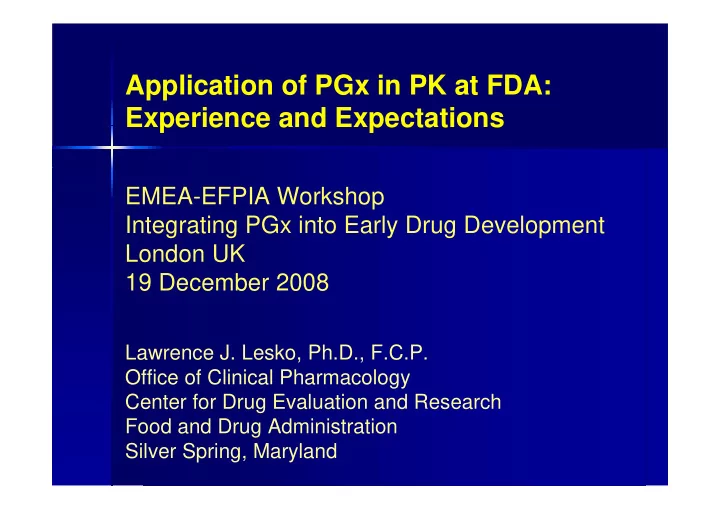

Application of PGx in PK at FDA: Experience and Expectations EMEA-EFPIA Workshop Integrating PGx into Early Drug Development London UK 19 December 2008 Lawrence J. Lesko, Ph.D., F.C.P. Office of Clinical Pharmacology Center for Drug Evaluation and Research Food and Drug Administration Silver Spring, Maryland
What Are the Goals of Preapproval Clinical PGx Studies? 1. To understand how genetic factors contribute to interindividual variability in PK and PD; can genotype distinguish D/R for benefit and risk 2. To inform the design of phase 2 and phase 3 clinical efficacy studies and provide insight into unexpected adverse events 3. To provide evidence to support labeling, and regulatory marketing and promotional claims
Table of Valid Genomic Biomarkers: Starting Point for PGx Characteristics 1.Biological plausibility 2.Validated assay is available 3.Demonstration of clinical utility http://www.fda.gov/cder/genomics/genomic_biomarkers_table.htm
When Should PGx Be Evaluated: Design Study and Analysis Around the Claim � When in vitro ADME and/or target receptor studies of NMEs have identified pathways known to be polymorphic (> 25% of total clearance) � When NMEs have wide interindividual variability in PK and steep D/R curves that might affect benefit or risk � When unexpected or unexplained outliers are observed in PK and/or PD studies � When PK and/or clinical response rates vary between racial or geographical subgroups � In phase 1 or early phase 2 to allow enrichment, dose stratification or subgroup analysis in later clinical studies
Specific Clinical PGx Studies: Opportunities for PGx Evaluation � Single and multiple dose PK and rising dose escalation studies; focus on valid ADME genes or on exploratory panels of genetic variants of large number of genes � Drug interaction studies; may be important to screen subjects genetically before studying to maximize extent of interaction – Drug interactions studies can signal the importance of pathway polymorphism by the magnitude of change in exposure � Dose-response studies; stratify dosing on genotype if prior PK studies suggest genetic factors are important � Special population studies; genotype may be useful to interpret results of, e.g., hepatic impairment studies
Two Options for Conducting Evaluation of PGx � Optimal approach: adequate and well-controlled study, prospectively designed to assess PK, PD and dose- response in subgroups based on genetic test � Pragmatic approach: retrospective analysis of a prospective trial under the following conditions – Biological hypothesis for genetically driven phenotype – Large enough sample to define genotype subgroups – DNA collection in large number of trial participants – Adequate and prespecified analysis plan – Assay with acceptable performance
Recent Experiences with PGx: Previously Approved and New Drugs � Tetrabenazine: doses over 50 mg/day should not be given without 2D6 testing; high exposure increases risk of depression and suicidality – Dose optimized in phase 3 � Clopidegrel: prodrug activated by 2C19; poor metabolizers have reduced metabolite levels and platelet response; may need higher dose – Drugs inhibiting 2C19 shown to similarly affect exposure and response – PGx studies may identify unnecessary drug interaction studies; DDI studies may identify unnecessary PGx studies
Prospective DNA Sample Collection in Clinical Studies: Information Value � Collect DNA samples from all participants enrolled in studies with implications for labeling and approval � Provide information to support the quality and integrity of the DNA in collected samples � Have a prespecified analysis plan prior to testing for retrospective or confirmatory subgroup analysis � Expect that possible relationships between genotype and phenotype may not be known at the time of study – Informed consent should anticipate this possibility � Assure accurate and complete descriptions of the phenotype especially with adverse events
PGx Provides Descriptive and Actionable Information in Product Labels � When results are positive (genetic factors important) – Recommend consideration of genetic testing – Recommend dose adjustments or maximum doses – Stratify patients most at risk for drug interactions � When results are negative (genetic factors unimportant) – Provide evidence for claim that gene variants do not influence PK and/or PD, or D/R
Labeling Implications of PGx � All genetic information found in PGx subsection of clinical pharmacology section and/or clinical section � Genetic information specific to, e.g., drug interactions appears in drug interaction section � Genetic information important to dosing, safety and/or efficacy reinforced in boxed warning, indications/usage, D/A, contraindications, warnings and precautions and adverse reaction sections � When genetic information is in the latter it also appears in “Highlights” section of label
Recommend
More recommend